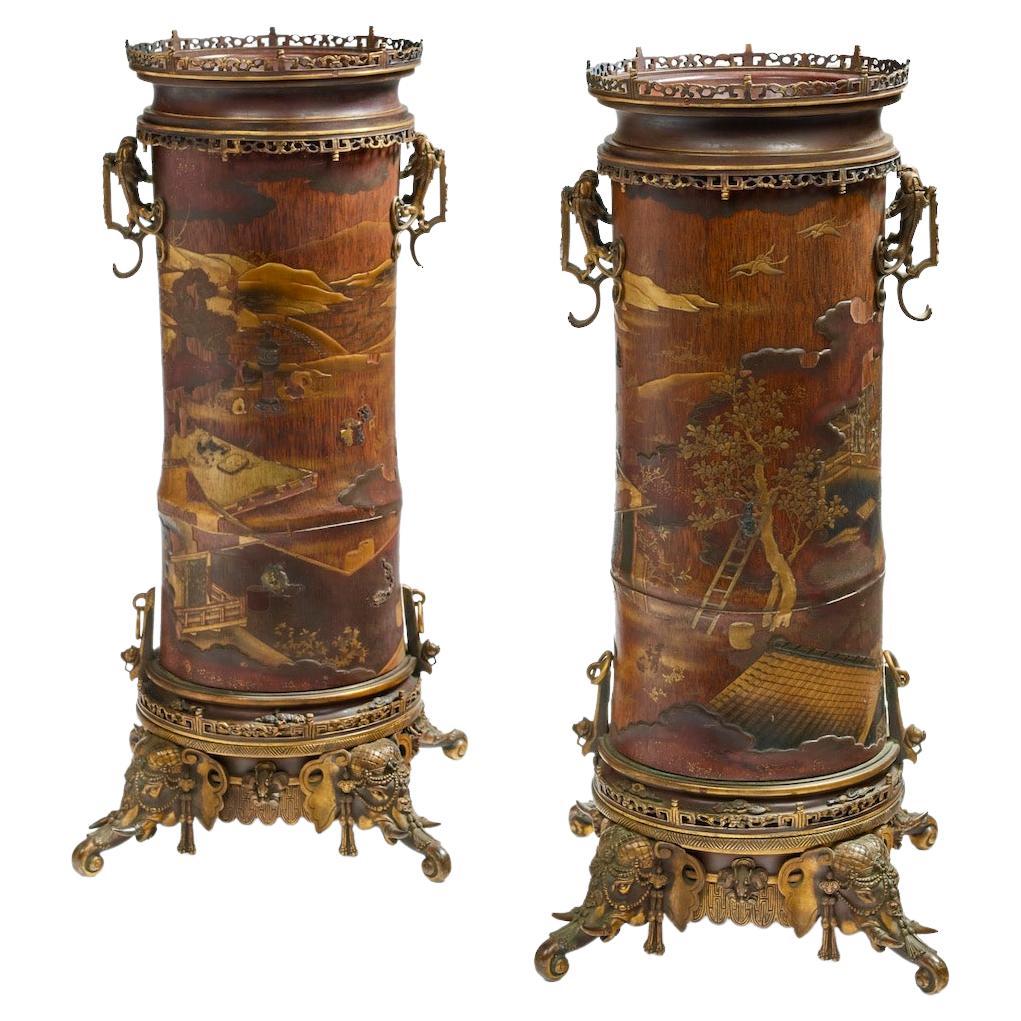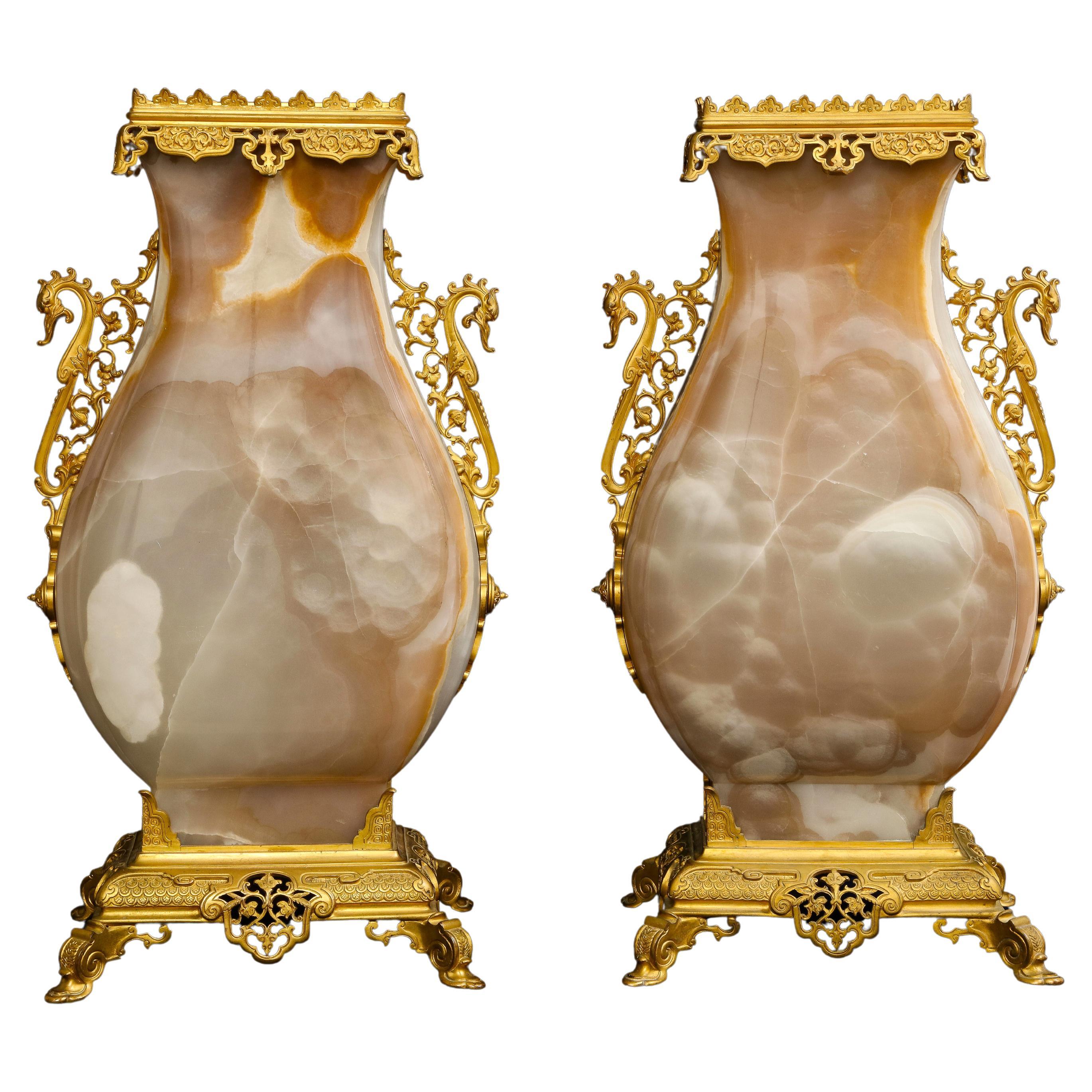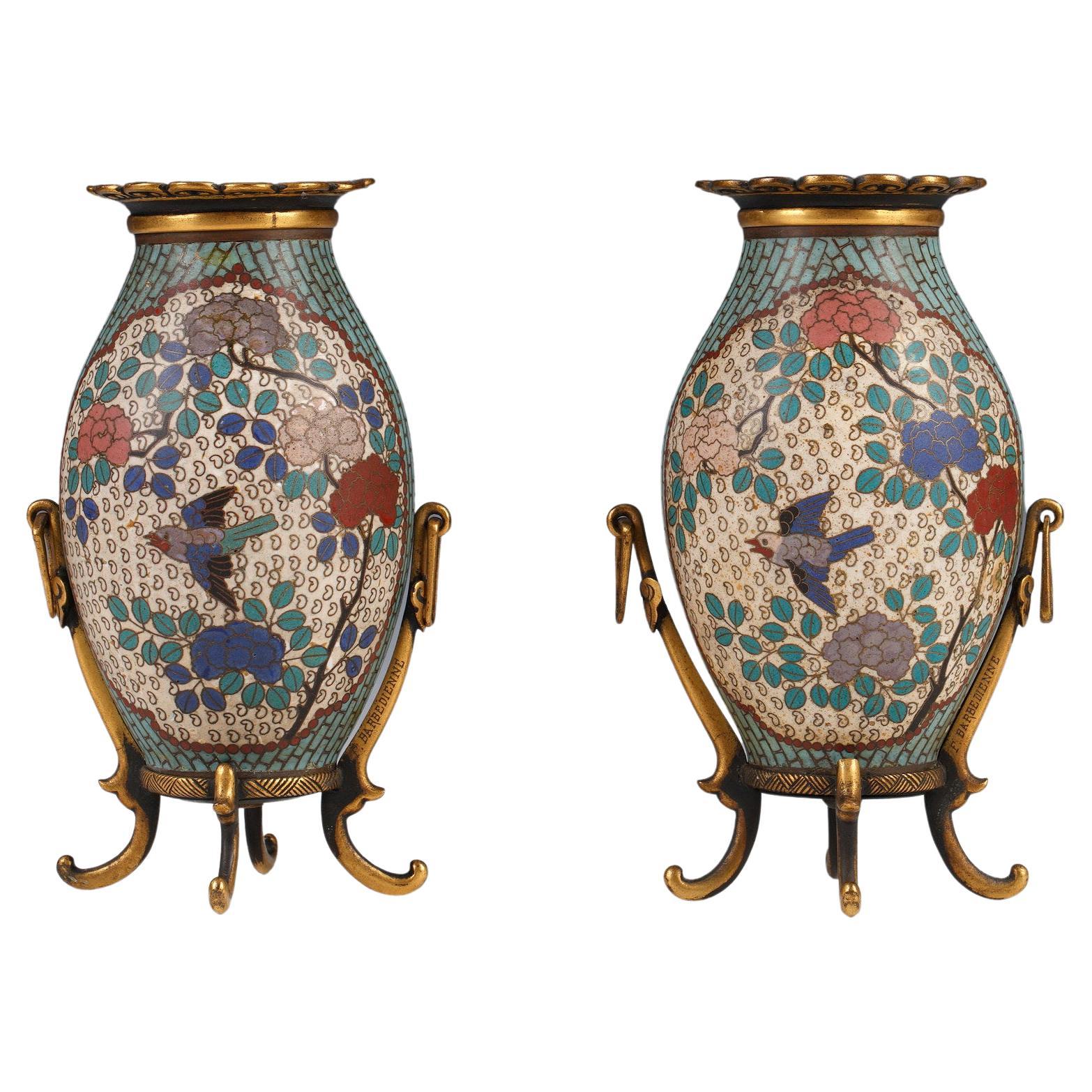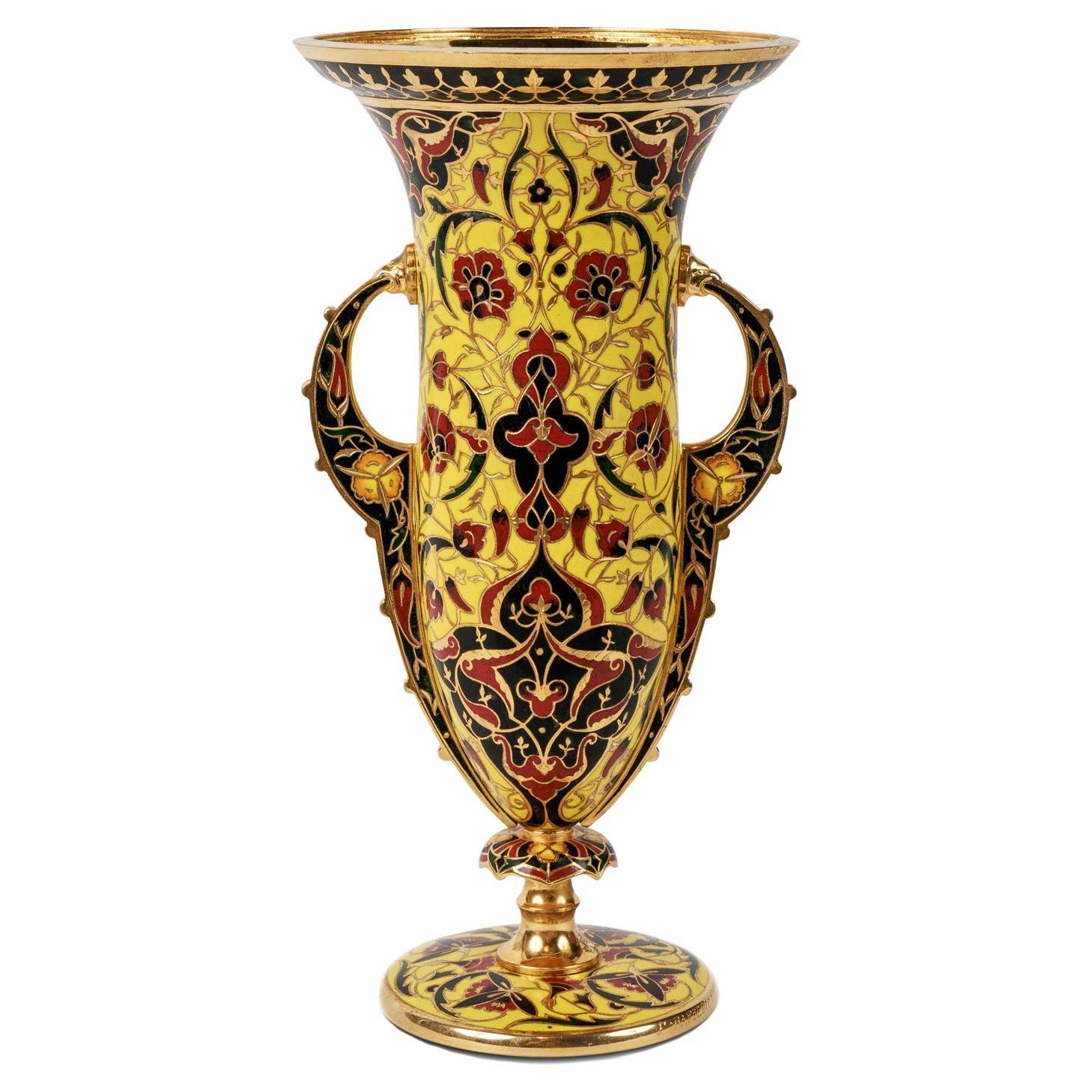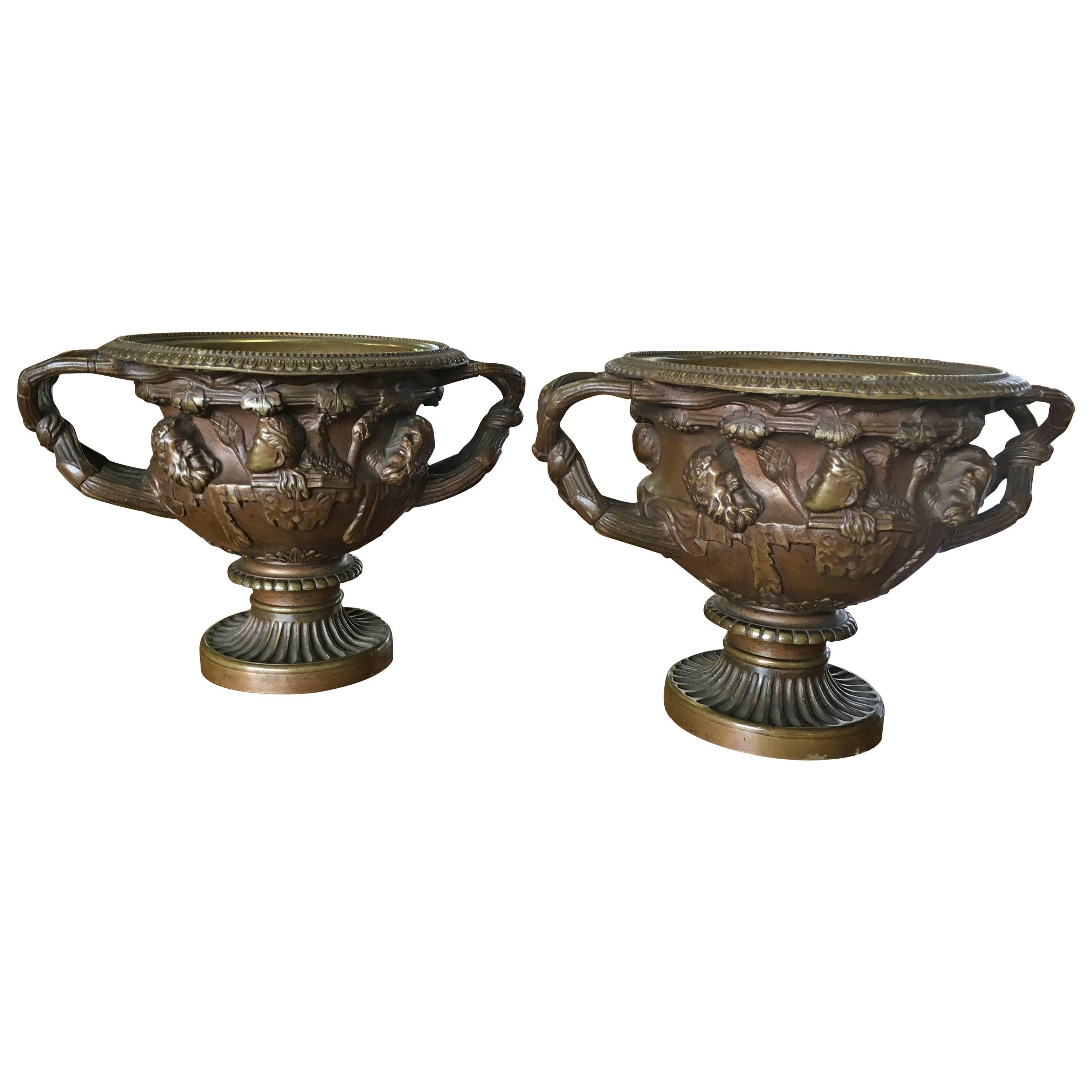Items Similar to Pair of French Japonisme Ormolu Vases E. Lièvre, Executed by F. Barbedienne
Want more images or videos?
Request additional images or videos from the seller
1 of 17
Pair of French Japonisme Ormolu Vases E. Lièvre, Executed by F. Barbedienne
About the Item
An important and monumental pair of very fine 19th century French Japonisme/Orientalist ormolu vases designed by Edouard Lièvre and Executed by Ferdinand Barbedienne. Each body with an oval shape, finely sculpted in a floral design, fringed by orientalist style handles with cartouches, the neck surmounted by a circular pierced scrolling dragon frieze. Each vase resting on a group of four orientalist style jeweled elephant heads, each base signed and inscribed: F. BARBEDIENNE.
Edouard Lièvre (1829-1886) was one of the greatest designers of the late 19th century. He was mostly known for his orientalist and Japonism styles. He designed many pieces, which were executed by F. Barbedienne and Christofle, and many retailed by A L'Escalier de Cristal, located near the Opera, 6 rue Scribe in Paris. These exceptional vases are very similar to the persian vase, executed by Lièvre, and exhibited at the Paris Expositions Universelles in the year 1878.
- Creator:Ferdinand Barbedienne (Metalworker),Edouard Lievre (Designer)
- Dimensions:Height: 38 in (96.52 cm)Width: 8 in (20.32 cm)Depth: 8 in (20.32 cm)
- Sold As:Set of 2
- Style:Japonisme (In the Style Of)
- Materials and Techniques:
- Place of Origin:
- Period:
- Date of Manufacture:1870
- Condition:Wear consistent with age and use.
- Seller Location:New York, NY
- Reference Number:1stDibs: f919519010213181131fs
About the Seller
4.9
Platinum Seller
These expertly vetted sellers are 1stDibs' most experienced sellers and are rated highest by our customers.
Established in 1820
1stDibs seller since 2011
137 sales on 1stDibs
Typical response time: 1 hour
- ShippingRetrieving quote...Ships From: New York, NY
- Return PolicyA return for this item may be initiated within 1 day of delivery.
More From This SellerView All
- Large Pair of 19 C. French Ormolu Mounted Carved Agate Vases, Att. to E. LievreBy Edouard LievreLocated in New York, NYA very large pair of 19th Century French Louis XVI Style Ormolu Mounted Carved Agate Vases, Attributed to Édouard Lièvre. Each vase is massive with a...Category
Antique 1860s French Louis XVI Vases
MaterialsAgate, Bronze
- French Japonisme Ormolu-Mounted Baccarat Crystal Vase with Bronze Turtle FeetBy Cristalleries De BaccaratLocated in New York, NYA Gorgeous and extremely rare French Japonisme ormolu-mounted turtle footed Baccarat crystal vase designed with a gilt turtle design, Baccarat stamp on bottom. The quality and craftsmanship of this piece is second to none. Baccarat crystal is known to be the best crystal in the world and this piece appropriately demonstrates that. The crystal vase is seated on four beautifully cast and hand-chiseled ormolu turtles, representing the Japanese artistic movement in France at the time, known as 'Japonisme'. The body of the vase is a gorgeously hand painted with raised gold and enamel decoration of a turtle and various other decorations, making it seem as though the turtle is swimming in a lake. Underneath the turtle are painted rocks and mosses, while above the turtle are cherry trees, dropping their fruit into the water. On the reverse of the main panel are two turtles swimming...Category
Antique 1880s French Japonisme Vases
MaterialsCrystal, Bronze
- A Large French Ormolu Mounted Japanese Blue & White Porcelain Vase/LampBy Edouard LievreLocated in New York, NYAn Incredible and Quite Large 19th Century French Ormolu Mounted Japanese Blue and White Porcelain Vase Turned to Lamp, The moun...Category
Antique 19th Century French Japonisme Table Lamps
MaterialsBronze
- Pr French Chinoiserie Silvered & Dore Bronze Mounted Honey Alabaster Vases/LampsBy Edouard LievreLocated in New York, NYA Marvelous Pair of 19th Century Antique French Chinoiserie Silvered and Dore Bronze Mounted Honey Alabaster Vases Turned to Lamps, in the style of Edouard Lievre. Each is beautifull...Category
Antique 1890s French Chinoiserie Vases
MaterialsAlabaster, Bronze
- Pair of 19th C. French Ormolu and Champleve Enamel Vases with Foo Lion HandlesBy Ferdinand BarbedienneLocated in New York, NYA fine and Large Pair of 19th century Orientalist Motif French Ormolu and Champlevé Enamel Vases with Foo Lion Handles of Magnificent quality and condition, Attributed to F. Barbedie...Category
Antique 1880s French Louis XVI Vases
MaterialsEnamel, Ormolu
- 19th C. French Islamic Champleve Enamel Vase and Underplate, Signed BarbedienneBy Ferdinand BarbedienneLocated in New York, NYA Fantastic 19th century French Islamic/Orientalist Style Champleve Enamel Vase and Underplate, Signed F. Barbedienne. The wide-mouthed vase terminates down a narrowing body and is m...Category
Antique 1850s French Islamic Vases
MaterialsBronze, Enamel
You May Also Like
- French 19th Century Pair of Lacquered Bamboos Japonisme VasesBy Ferdinand Barbedienne, Edouard LievreLocated in Saint-Ouen, FRA 19th French century pair of Lacquered Bamboos Japonisme vases. An amazing pair of tall cylindrical bamboo vases decorated in Japanese Gold and Sil-ver Hiramaki-E Lacquer with Pavilions in The Mist and Weaving Figures, Flown Over by a Pair of Cranes. Enclosed in a Sino-Japanese Inspiration Golden and Brown Patina Bronze Mount Featuring Elephant Heads, Partially Openwork Branches and Salamanders Forming Side Handles. Circa 1870 Attributed to Édouard Lièvre (1828-1886) and Ferdinand Barbedienne (1810-1892) Édouard Lièvre (1828-1886) is one of the most talented and prolific designer and industrialist of the 19th Century, his repertoire is sometimes Sino-Japanese or Neo-Renaissance, whether in furniture or works of art, we can note in particular the parade bed of Valtesse de La Bigne, furniture commissioned by the painter Édouard Detaille or even Sarah Bernhardt, and the famous works in collaboration with Maison Christofle or those in gilded bronze and cloisonné enamel edited by Ferdinand Barbedienne, presented at the Universal Exhibitions in 1878, 1889 and 1900. He was both a draftsman, painter, illustrator, engraver, ornamentalist and cabinetmaker, first trained in the studio of the painter Thomas Couture, Lièvre was then fully immersed in the world of decoration, creation and ornamentation and provides designs for manufacturers and merchant-publishers. Often assisted by his brother Justin, he first produced works of art for his own apartment, seeking out the finest craftsmen to execute his designs for bronzes, ceramics, fabrics and luxury furniture from great virtuosity and great taste. He then collaborated with the cabinet-maker Paul Sormani, as well as haberdasher merchants such as the Escalier de Cristal, bronziers such as Maison Marnyhac and especially Ferdinand Barbedienne as on our vases with bronze mounts characteristics of Edouard Lièvre's work. Born in 1810, died in Paris in 1892, Ferdinand Barbedienne, the most important caster of bronze pieces of art during the second half of the 19th Century, created and directed in Par-is one of the major artistic foundries of his time. Barbedienne specialized in classical reproductions, whose models were exposed in famous European museums. Their illustrated catalogues included many diverse objects such as busts, ornemental sculpture (clocks, candelabras, cups) sometimes even life-sized and bronzes for furniture. Apart from his own produc-tion, Barbedienne worked for the most renowned sculptors such as Barrias, Clésinger and Carrier-Belleuse. All his works were highly esteemed and he, himself honored by contemporary critics. At the London exhibition in 1851 Barbedienne’s firm won two « Council medals ». At the 1855 Universal Exhibition, he won a medal of honor. The success of Barbedienne’s firm brought him many official commissions, such in about 1860, as Barbedienne supplied bronzes for furniture for the Pompeian Villa of Prince Napoléon-Joseph, located avenue Montaigne in Paris. At the London Universal Exhibition of 1862 Barbedienne won medals in three different categories: Furniture, Silversmith work and Artistic bronzes. Barbedienne was made an officer of the Légion d’Honneur in 1867 and Commander in 1878 when he was compared with « a prince of industry and the king of bronze casting ». His glory did not decline with the passage of the time for at the Universal Exhibition of 1889 the critics thanked Barbedienne for the example he set for other bronze-casters by the perfection of his bronzes. “Japonisme” in the second half of the 19th century, was a craze for everything that came from Japan or imitated its style. The word was first coined in a series of articles published by Philippe Burty, from May 1872 to February 1873, in the French magazine “la Renaissance Littéraire et Artistique”. Far from the Academic sphere, artists seeking for new ways of expression, appropriated this discovery. Manet and the impressionists led the way to half a century of enthusiasm for Japanese art, and largely contributed to the esthetical revolution Europe experienced between 1860 and the beginning of the twentieth century. From 1862, The World’s Fairs provoked massive arrivals of fans, kimonos, lacquers, bronzes, silks, prints and books that launched the real era of Japonisme. With those exhibitions, the demand was boosted, the number of merchants and collectors was multiplied, and artists became passionate about this new esthetic. For them, its “primitivism” was probably its most important quality: artists were fond of the Japanese art’s capacity to be close to nature and to reconcile art and society by representing, with a lot of care, the most trivial objects. In painting, Edouard Manet, Mary Cassatt, Degas, Van Gogh, Gauguin were among those who were deeply inspired by Japanese art, affected by the lack of perspective and shadow, the flat areas of strong color, the compositional freedom in placing the subject off-center, with mostly low diagonal axes to the background. The Japanese iris, peonies, bamboos, kimonos, calligraphy, fish, butterflies and other insects, the blackbirds, cranes and wading birds, the cats, tigers, and dragons were endless sources of inspiration, appropriation, and reinterpretation for European artists. The occidental productions were combining styles and artistic conceptions instead of copying Japanese art slavishly. That is what brings to light the comparison between the artworks of Kitagawa Utamaro and Degas, of Katsushika Hokusai and Van Gogh The World’s Fairs of 1851 and 1862 in London, those of 1867, 1878, 1889 and 1900 in Paris, of 1873 in Vienna and of 1904 in Saint Louis presented a number of “Japanese-Chinese” installations with earthenware, bronzes, screens and paintings and attracted the largest amounts of visitors In Vienna, the “Japanese village...Category
Antique 1870s French Japonisme Vases
MaterialsBronze
- Pair of Small Cloisonné Enamel Vases by F. Barbedienne, France, Circa 1880By Ferdinand BarbedienneLocated in PARIS, FRSigned F. Barbedienne on the mount. Charming pair of small curved-shaped vases in patinated and gilded bronze and polychrome cloisonné enamel decorated with flowers and birds. With ...Category
Antique 1880s French Japonisme Vases
MaterialsBronze, Enamel
- French Japonisme Lacquered Metal Jardinière on Ormolu Stand Signed MarnyhacBy Maison Marnyhac 1, Edouard LievreLocated in Saint-Ouen, FRJardinière Médicis vase shape in copper with gold lacquered decoration on a burgundy background of a Japanese landscape with a volcano and an eagle ...Category
Antique 1870s French Japonisme Planters, Cachepots and Jardinières
MaterialsMetal, Bronze
- Ferdinand Barbedienne, A French Ormolu and Champleve Enamel Vase, C. 1870By Ferdinand BarbedienneLocated in New York, NYFerdinand Barbedienne, A French Ormolu and Champleve Enamel Vase, C. 1870 In the Islamic / Alhambra taste. The two handled vase in Alhambra form, enameled in rich yellow throughout ...Category
Antique 19th Century French Napoleon III Vases
MaterialsBronze, Ormolu, Enamel
- 19th Century Pair of French Bronze Vases by F. BarbedienneBy Ferdinand BarbedienneLocated in Sofia, BGA wonderful pair of bronze vases with high relief by Bardedienne. France, circa 1870.Category
Antique Late 19th Century French Vases
MaterialsBronze
- Extremely Rare Pair of Ferdinand Barbedienne Ormolu and Champlevé Enamel VasesBy Louis-Constant Sevin, Ferdinand BarbedienneLocated in New York, NYAn extremely rare, museum quality pair of Ferdinand Barbedienne ormolu and champlevé enamel vases, circa 1870, certainly designed by Louis Constant Sevin...Category
Antique 19th Century French Napoleon III Vases
MaterialsEnamel, Ormolu
Recently Viewed
View AllMore Ways To Browse
French Ormolu Vases
Pair Ormolu Vases
Christofle Paris
Christofle A Paris
Monumental Paris
Pair French Ormolu Vases
Vase Pierced
19th Century Japonisme
Pair Of Vase Ormolu Bronze
Pair Gold Vase With Handles
Bronze Signed For Vase
Pair Vases French Floral
Gold Head Vase
Vases Frieze
Orientalist Style
Pair Of Vase With Ormolu Bronze
Four Handle Vase
Japonisme Gold
